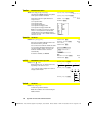
520 Appendix A: Functions and Instructions
8992APPA.DOC TI-89 / TI-92 Plus: Appendix A (US English) Susan Gullord Revised: 02/23/01 1:48 PM Printed: 02/23/01 2:21 PM Page 520 of 132
zeros({expression1, expression2}, {varOrGuess1,
varOrGuess2
[
, …
]
})
⇒
matrix
Returns candidate real zeros of the
simultaneous algebraic
expressions
, where
each
varOrGuess
specifies an unknown whose
value you seek.
Optionally, you can specify an initial guess
for a variable. Each
varOrGuess
must have the
form:
variable
– or –
variable
=
real
or
non
-
real
number
For example,
x
is valid and so is
x=3
.
If all of the expressions are polynomials and
if you do NOT specify any initial guesses,
zeros()
uses the lexical Gröbner/Buchberger
elimination method to attempt to determine
all
real zeros.
For example, suppose you have a circle of
radius r at the origin and another circle of
radius r centered where the first circle
crosses the positive x-axis. Use
zeros()
to find
the intersections.
As illustrated by r in the example to the right,
simultaneous
polynomial
expressions can
have extra variables that have no values, but
represent given numeric values that could be
substituted later.
Each row of the resulting matrix represents
an alternate zero, with the components
ordered the same as the
varOrGuess
list. To
extract a row, index the matrix by [
row
].
zeros({x^2+y^2
ì
r^2,
(
x
ì
r
)
^2+y^2
ì
r^2
}
,
{
x,y
})
¸
r
2
3
ø
r
2
r
2
ë
3
ø
r
2
Extract row 2:
ans(1)[2]
¸
r
2
ë
3
ø
r
2
You can also (or instead) include unknowns
that do not appear in the expressions. For
example, you can include z as an unknown to
extend the previous example to two parallel
intersecting cylinders of radius r. The
cylinder zeros illustrate how families of zeros
might contain arbitrary constants in the form
@
k
, where
k
is an integer suffix from 1
through 255. The suffix resets to 1 when you
use
ClrHome
or
ƒ
8:Clear Home
.
zeros({x^2+y^2
ì
r^2,
(
x
ì
r
)
^2+y^2
ì
r^2
}
,
{
x,y,z
})
¸
r
2
3
ø
r
2
@1
r
2
ë
3
ø
r
2
@1


















